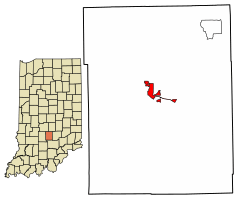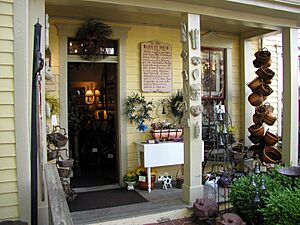Nashville, Indiana facts for kids
Quick facts for kids
Nashville, Indiana
|
|
|---|---|

Nashville, Indiana
|
|

Location of Nashville in Brown County, Indiana.
|
|
| Country | United States |
| State | Indiana |
| County | Brown |
| Township | Washington |
| Area | |
| • Total | 1.61 sq mi (4.16 km2) |
| • Land | 1.60 sq mi (4.15 km2) |
| • Water | 0.01 sq mi (0.01 km2) |
| Elevation | 620 ft (190 m) |
| Population
(2020)
|
|
| • Total | 1,256 |
| • Density | 784.02/sq mi (302.72/km2) |
| Time zone | UTC-5:00 (Eastern (EST)) |
| • Summer (DST) | UTC-4:00 (EDT) |
| ZIP code |
47448
|
| Area code(s) | 812 |
| FIPS code | 18-52038 |
| GNIS feature ID | 2396797 |
| Website | http://townofnashville.org/ |
Nashville is a small town located in Brown County, Indiana, in the United States. It's the main town in Brown County and serves as its county seat, which means it's where the county government is located. In 2020, about 1,256 people lived here. Nashville is famous for its lively Brown County Art Colony and as a popular place for tourists to visit.
Contents
Exploring Nashville's Past
The land where Nashville now stands was first settled after agreements were made with native populations. These agreements included the 1809 Treaty of Fort Wayne and the 1818 Treaty of St. Mary's.
How Nashville Began
A man named Banner C. Brummett founded the town in 1836. It was first called Jacksonburg. By 1830, only about 150 people lived in the entire county. Nashville built its first courthouse and a jail in 1837. The county's population grew to 2,364 by 1840. Nashville officially became a town in 1872.
Challenges and Changes
Around the year 1900, a lot of trees were cut down in the area. This caused serious problems with the soil washing away.
A Hub for Artists
In the early 1900s, many artists came to live in Nashville. One of the most famous was T. C. Steele, an American Impressionist painter. These artists formed the Brown County Art Colony. This art community is still active today as the Brown County Art Guild.
Two important historical sites in Nashville, the Brown County Courthouse Historic District and the F.P. Taggart Store, are listed on the National Register of Historic Places. This means they are recognized for their historical importance.
Nashville's Geography and Climate
Nashville covers about 1.01 square miles (2.62 square kilometers) of land.
Understanding the Landscape
Nashville is known for its rolling hills, ridges, and valleys. These features were shaped by the north fork of Salt Creek. The hills around Nashville are made of sandstone, siltstone, and shale. These rocks were formed long ago in an ancient river delta, similar to the Mississippi River delta today.
Salt Creek (to the south), Greasy Creek (to the east), and Jackson Branch Creek (to the west) have carved out the land, creating Nashville's hilly landscape. Lake Monroe, the largest lake in Indiana, was created by building a dam on Salt Creek south of Bloomington.
Weather in Nashville
Nashville has a climate with hot, humid summers and winters that are usually mild to cool. This type of weather is called a humid subtropical climate.
Population of Nashville
| Historical population | |||
|---|---|---|---|
| Census | Pop. | %± | |
| 1870 | 270 | — | |
| 1880 | 348 | 28.9% | |
| 1890 | 395 | 13.5% | |
| 1900 | 393 | −0.5% | |
| 1910 | 354 | −9.9% | |
| 1920 | 323 | −8.8% | |
| 1930 | 369 | 14.2% | |
| 1940 | 493 | 33.6% | |
| 1950 | 526 | 6.7% | |
| 1960 | 489 | −7.0% | |
| 1970 | 527 | 7.8% | |
| 1980 | 705 | 33.8% | |
| 1990 | 873 | 23.8% | |
| 2000 | 825 | −5.5% | |
| 2010 | 803 | −2.7% | |
| 2020 | 1,256 | 56.4% | |
| U.S. Decennial Census | |||
What the 2010 Census Showed
In 2010, the census counted 803 people living in Nashville. There were 359 households, and 167 of those were families. The town had about 795 people per square mile (307 per square kilometer).
Most residents (98.1%) were White. A small number were African American, Native American, or Asian. About 0.7% of the population was Hispanic or Latino.
About 15.9% of households had children under 18. Many households (48.5%) were made up of single individuals. The average age in town was 59.7 years old.
Education in Nashville
Nashville is home to the main campus of the Brown County School District. This is the only school system in Brown County.
Local Schools
The schools in Nashville include Brown County Middle School, which serves students in grades 6-8. Brown County High School teaches students from grades 9-12. The main office for the Brown County School Corporation is also in Nashville. It is often called the "White House."
Nashville also has a public library. It is a part of the Brown County Public Library system.
Arts, Culture, and Tourism
Nashville's tourism industry is built around its local artists and the beautiful natural scenery.
Popular Attractions
For example, the Brown County State Park is just outside of town. Downtown Nashville is full of art, antique, and specialty shops. You can also find galleries, restaurants, and entertainment places. Many inns, rented cottages, and bed and breakfast establishments welcome visitors. Some tours even offer tastings at local wineries and distilleries.
Nashville was once home to the John Dillinger Museum. This museum later moved to Hammond.
See also
 In Spanish: Nashville (Indiana) para niños
In Spanish: Nashville (Indiana) para niños



